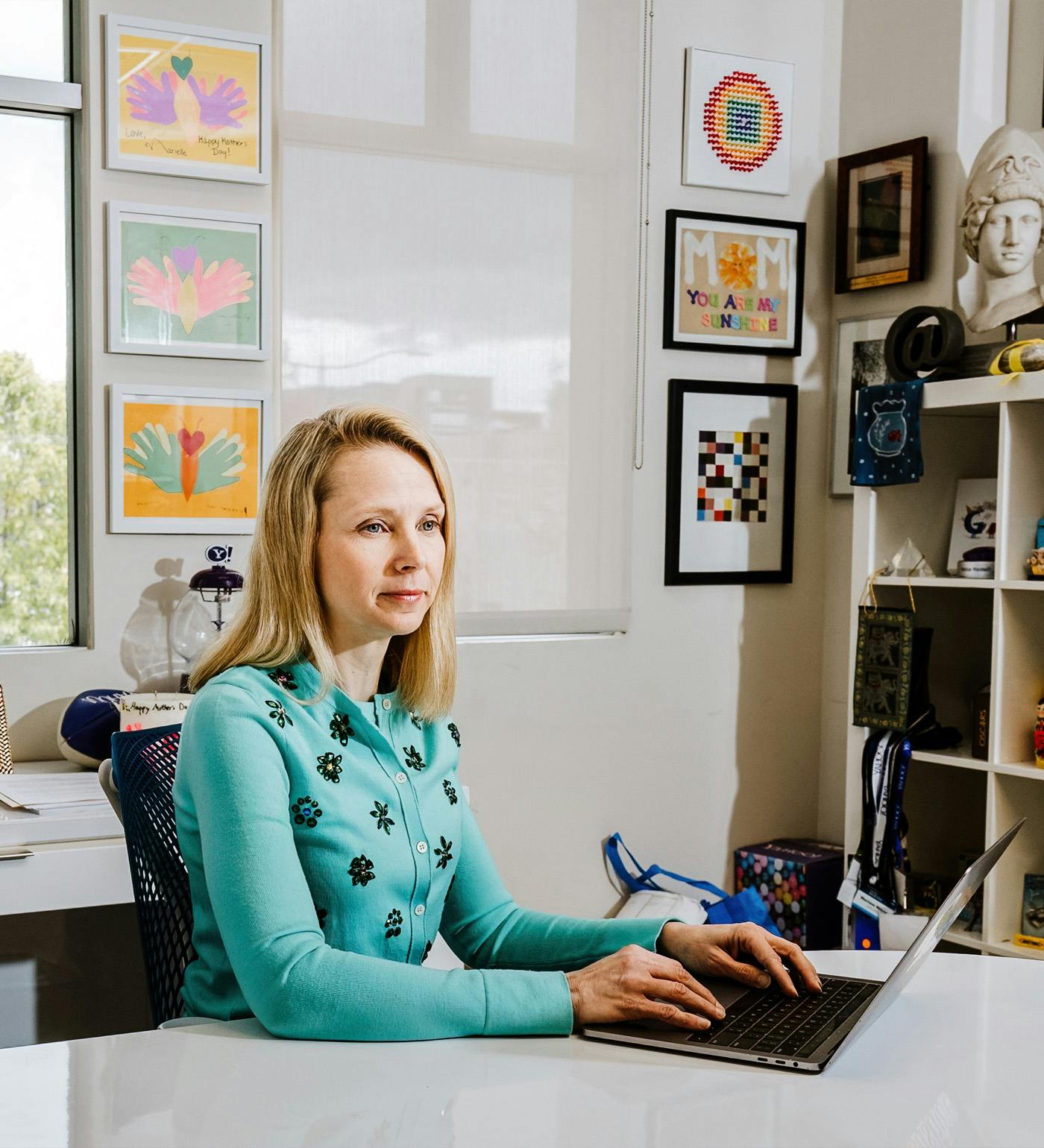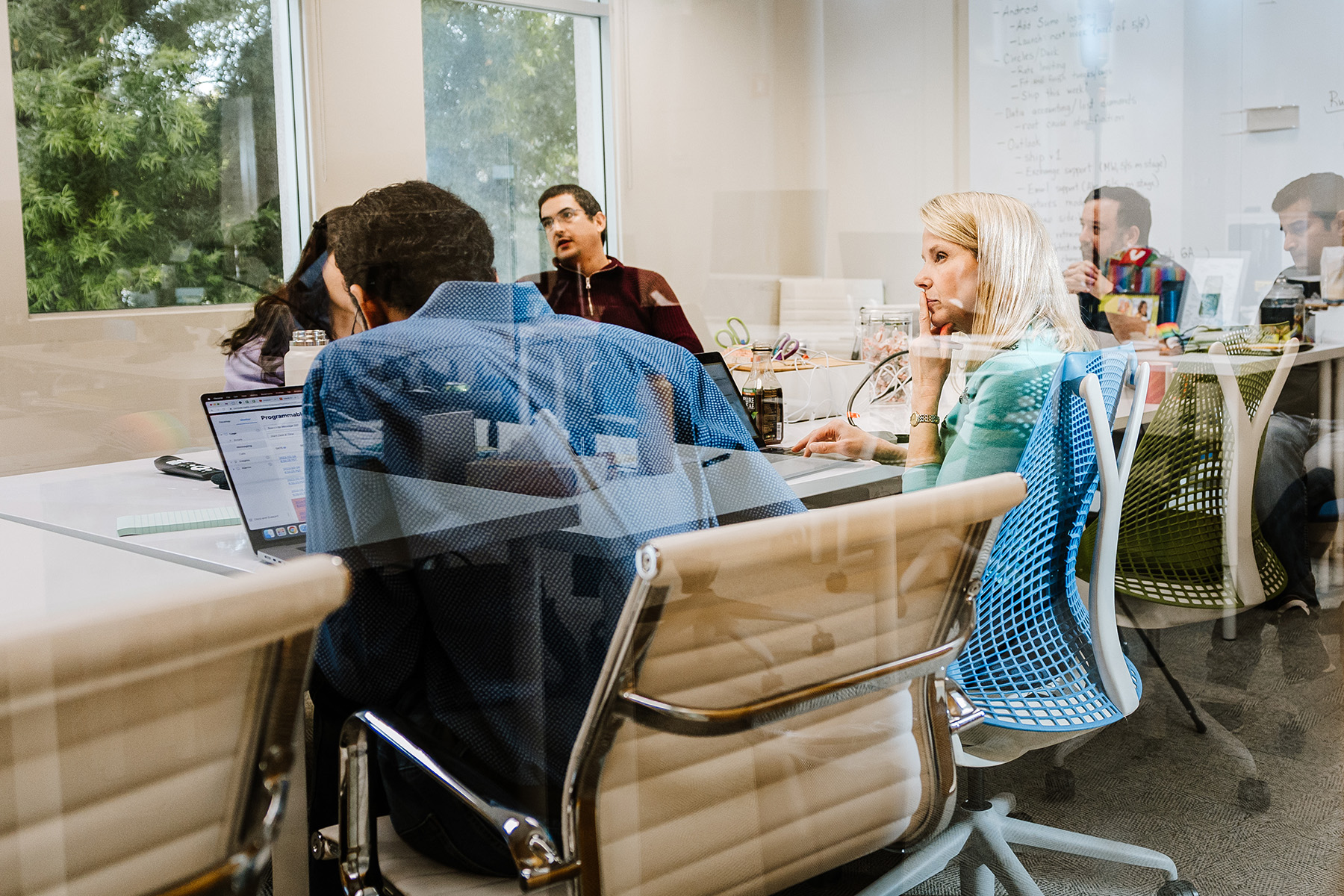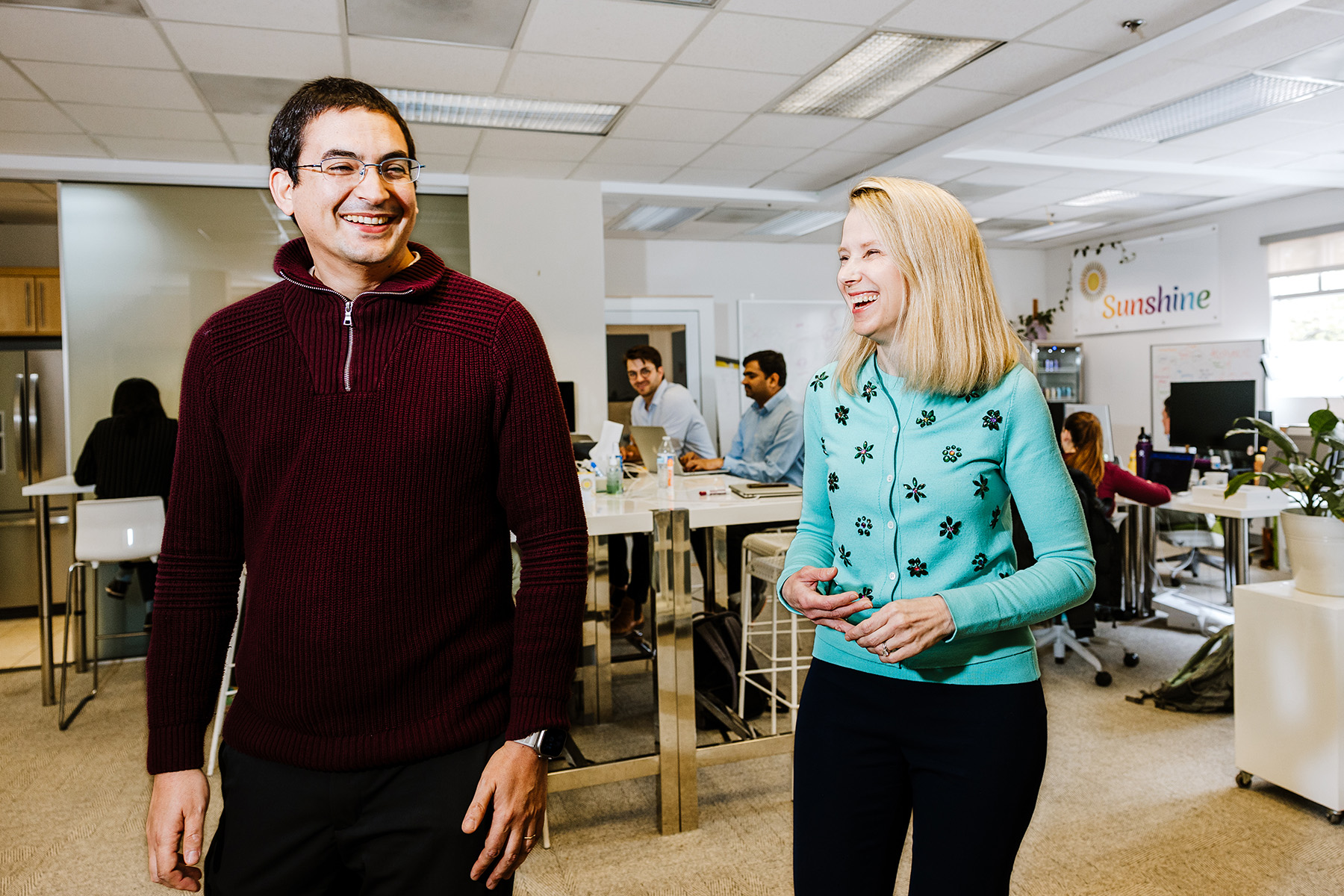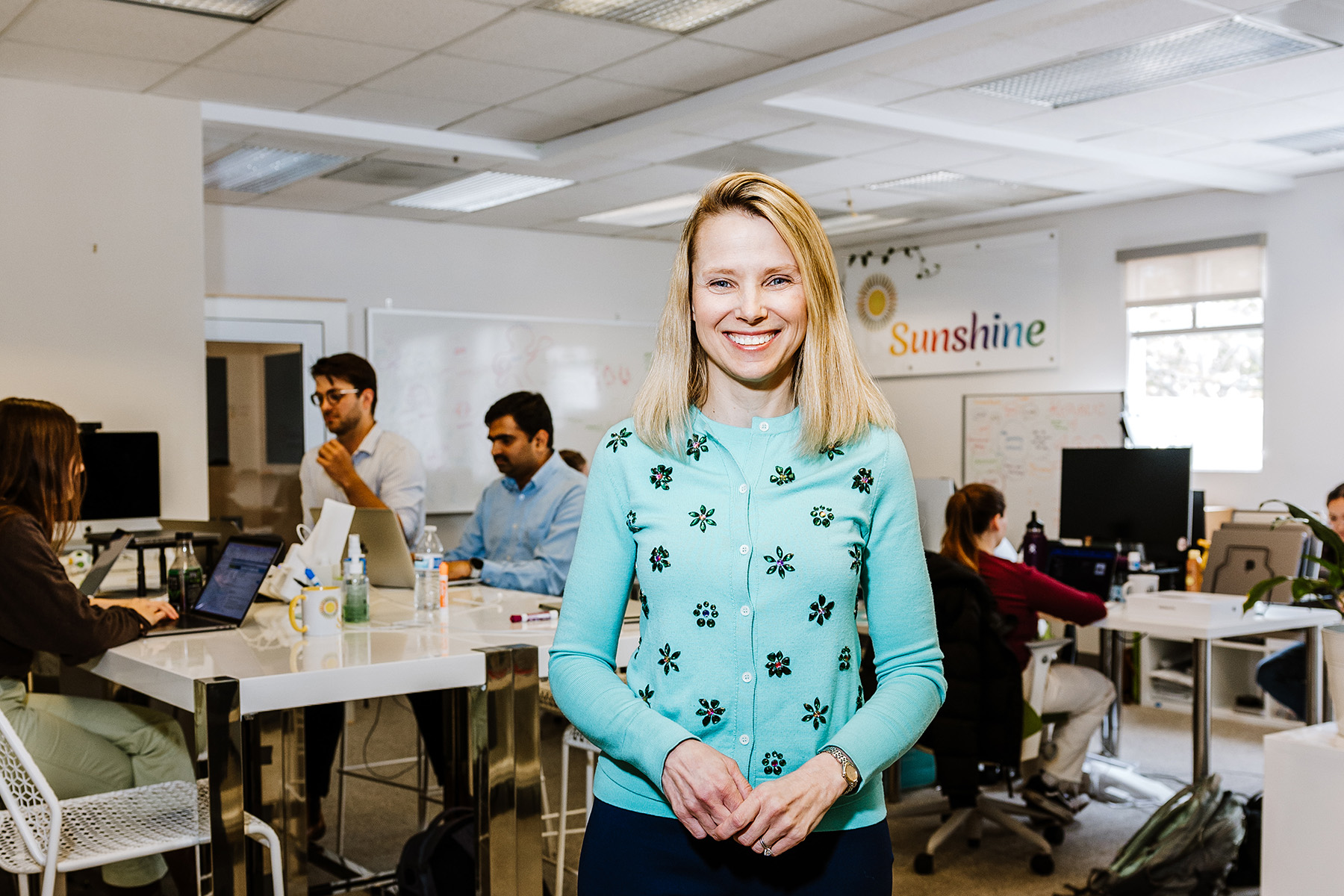
 Marissa Mayer in the office of her startup, Sunshine. Photograph by Carolyn Fong for The Information
Marissa Mayer in the office of her startup, Sunshine. Photograph by Carolyn Fong for The InformationCan Marissa Mayer Eclipse Herself?
She was Google’s breakout star. She was CEO of Yahoo. Now, with her startup Sunshine, Mayer attempts to step out of her own shadow.
Earlier this year, Marissa Mayer—signature blond bob, talking a mile a minute—taught a class on how to start your own company. It had been five years since Mayer had become a startup founder herself, and she had prepared a slide deck describing the finer details of entrepreneurship. As she clicked through the presentation, her audience fidgeted in their seats. They were fourth graders.
Mayer had come to her son’s classroom in Silicon Valley for “intersession,” a reprieve from the usual schoolwork when parents teach their own material. The fourth graders had been studying Joseph Campbell's “hero’s journey,” and Mayer seized on the opportunity for metaphor. “Almost every entrepreneur’s journey is a hero’s journey,” she told the children. There is the commitment to the quest, a long road filled with trials and invariably a confrontation with one’s own limitations. She told the story of Steve Jobs, who had been kicked out of his own company before returning to make Apple one of the most legendary businesses of all time.
Mayer offered less of her own mythology, but what a tale she could tell: Once upon a time, a young woman left the ordinary world (Wausau, Wis.) to answer the call of adventure (Stanford University), where she met a pair of wizards (Larry Page, Sergey Brin) and entered the belly of the whale (Google, where she was employee 20). Along the way, she made allies and enemies, fell in love with a handsome prince (investor Zack Bogue), and encountered grave and daring tests of her resolve. Her climactic battle (becoming CEO of Yahoo in 2012) ended in a near-death experience (selling Yahoo to Verizon in 2017), leaving her battered but alive. Now, five years later, she had made it to a later stage in the hero’s journey: resurrection. This is when the hero must use everything they’ve learned to face one final test, so they can bring their elixir of knowledge back to the ordinary world.
In Silicon Valley, Mayer is a celebrity if not a hero. Over the course of her two-decade career in tech, she has earned an enormous amount of recognition and an even greater store of folklore. There are countless legends about her—stories about her superhuman capacity for work, the 250 all-nighters she pulled in her first five years at Google, the team meetings she scheduled in the middle of the night. There was the time she tested 41 shades of blue to find exactly the right color for Google’s hyperlinks. The time when, ordering cupcakes for her Christmas party, she sent the bakery more than a dozen annotated pictures of ornaments she liked, and asked it to design a set of custom ornament-shaped cupcakes. Then she invested in the bakery itself.
John Battelle, a technology journalist who wrote a book about Google, once said he’d “never had a conversation with her when she wasn’t completely certain she was right.” Eric Schmidt, former CEO of Google, called her “one of the smartest, most talented leaders the tech world has ever known.”
So when Mayer decided to start a company in 2018, an aura of intrigue followed her. What would she do with her precious elixir of knowledge? How would Mayer—a person so revered that several investors told me they would have backed anything she wanted to do after Yahoo—choose to spend her valuable time?
The answer was phone contacts.
“Everyone’s contacts are messy,” Mayer told me in early April, sitting in her colorful office in Palo Alto, Calif. Her startup, Sunshine, makes an app to clean up digital address books and will soon roll out a new product, Circles, for organizing contacts into groups, as well as other products for invitations and events. It’s these launches that have given Mayer the incentive to invite in the press again after a few years of silence. “Contacts, relationship management, groups, events—they’re all messy, and they’re not integrated well,” she continued. “The opportunity is here. And we’re in this moment where there is a real explosion in terms of the technology that can support all of this.”
Mayer knows what you’re thinking: This idea sounds...small. And maybe difficult to monetize? It’s like Beowulf herding sheep rather than battling the monster Grendel. She almost called the company Mundane AI, she said, because “it expresses what we’re trying to do, which is to take smart, interesting technology and apply it to really mundane things.” But Mayer has long wondered how it was possible that companies could build cars that drive themselves or rockets that send Jeff Bezos into space, yet her native contacts app couldn’t tell whether the two Chris Andersons stored on her phone were the same person or not.
The mundane stuff—the cupcakes shaped like ornaments, the blue in the hyperlinks—were actually the things that touched people’s lives most often. If no one else was going to fix them, then Marissa Mayer would.
Certain parts of the Mayer mythology are true: She likes to work more than she likes to rest. She would rather try, fail and try again than never try at all. She also believes, genuinely, that Sunshine can ease how we connect with other people, both on and off our phones—and if she’s right, there’s a chance she could produce another hit. “There are countless companies that would want her as president or CEO,” said Ben Ling, founder and general partner of Bling Capital, who worked with Mayer at Google for eight years and shared an office with her for three. “But is this what she wants to be doing? Yes. She can afford to choose what she wants to do.” (Ling invested in Sunshine’s $20 million seed round in 2020.)

Sunshine’s employees work together in person five days a week out of a squat building in downtown Palo Alto. The building was the first office of Facebook, a fact marked by a plaque outside in the shape of a thumbs up. (The first time I visited, one of Sunshine’s employees cheerfully noted that Mark Zuckerberg used to walk barefoot on these very floors.) Inside, there are mementos from Mayer’s past everywhere: an enormous teddy bear, a gift from Google executive David Lawee, wearing a purple wig and purple tutu (Yahoo’s colors); a statue of the head of Athena that has followed Mayer all the way from her first office at Google; a spray of primary colors, which Mayer thinks of as a Sunshine thing (“because sunshine makes rainbows”).
On a recent Thursday, Mayer presided over the morning meeting, wearing a turquoise sweater set with appliqué sequin flowers. Her co-founder, Enrique Muñoz Torres—a former executive at Yahoo and senior product manager at Google—sat opposite, noting status updates on a whiteboard. How was progress going on the Android roll-out? Any updates on Circles, the groups product?
As Mayer and Muñoz Torres conveyed it to me, contacts are the first step in a series of interrelated products Sunshine plans to work on. Once you have the correct contact information for everyone you know, you can see how those people relate to each other, and you can start to group them. Once you have groups (family members, neighbors, the people you’d actually invite to your birthday party), you can help all those people to get in touch with each other and plan events in the real world. You could automatically share all of the photos from a party with people on the invitation list, or use contact information to generate Venmo requests for a recent group trip. You might also pay for those premium features, which is how Sunshine plans to make money. “So that’s where we want to go, using the work we’ve done in contacts as the foundation,” Muñoz Torres said.
For now, just getting the contacts straight remains a Herculean effort. Some contacts are correct but incomplete. Others have out-of-date information, like an old work email address. Sometimes two contacts need merging, but other times they are separate people with the same name. In Mayer’s address book, there are two Margaret Stewarts, two Jason Wheelers, two Chris Andersons, a Laurie Stern and a Lori Stern. “So our job is to figure out if it’s the same person or not,” she told me.
When Sunshine gets this right, people hardly notice. But the cost of getting it wrong is enormous. Not long ago, Sunshine tested a technology that scraped email signatures for additional contact information. It worked, except that it mistook embedded signatures—the ones that show up in the thread of email replies—for the original contact’s information. Mayer, who beta-tests everything herself, ended up in a situation where she thought she was calling someone to complain about her contractor and ended up calling the contractor himself.
“The user tolerance for mistakes is nonexistent,” Muñoz Torres said. For most problems in technology, a success rate of 90% is considered pretty good. Companies like Google have errors baked into most of their processes; for every search query, you get a heap of options, and hopefully one of them is right. But with contacts, a single error can be disastrous.
Partly for that reason, Sunshine has veered more toward human intelligence than artificial intelligence in its technology. “We aspire to have more AI involved, but we also want to make sure we produce a product that’s reliable,” Mayer said. The company did recently start using OpenAI’s GPT-4 model to correct business names in contact cards and is also developing internal models to enrich contact data.
In the conference room, Mayer and Muñoz Torres reviewed the data from a recent test, an improved system to scrape email signatures that used machine learning. The machine-learning system worked much better. But then, halfway through the meeting, someone noticed a problem: The new AI had an odd habit of making spurious name changes. A contact named “Rich” got renamed “Richard,” and one named “Francisco” got renamed “Fernando.”
The machine-learning engineer squinted at the screen. “That’s a big problem. I’m going to review the data again,” she said. Mayer was quick to offer ideas: “We should see if it’s just an error in what we’re doing. Otherwise we’re going to have to go back and do a heuristics step afterward,” she said. “How long do you think you need to make the corrections?”
The engineer gave the answer Mayer and Muñoz Torres wanted to hear: She promised to review the data by the end of the day.
At Google, Mayer wasn’t a stand-out coder, but she quickly made herself indispensable in other ways. She joined the company in 1999, straight out of Stanford, and by the end of her first year she had become the person approving all of Google’s user interfaces and setting the agenda on what products it would roll out next. “She is more responsible than anyone else for the look and feel of Google,” Schmidt, Google’s former CEO, wrote in an email. “She worked harder in terms of hours and efforts than anyone else, and her productivity was just incredible.”
By 2005, Mayer had become Google’s vice president in charge of consumer products, a fast-rising star at a fast-growing company. She had also become an object of fascination in the press. The New York Times credited her for “putting a bolder face on Google,” describing her as “the ‘it girl’ at one of the world’s hottest companies.” She was photographed in Vogue wearing Michael Kors and Yves Saint Laurent. The media paid an incredible amount of attention to her appearance. “Mayer calls herself a geek, but she doesn’t look the part,” Nicholas Carlson wrote in his 2015 book “Marissa Mayer and the Fight to Save Yahoo.” Various outlets described her as a “glamour geek” and “Grace Kelly gorgeous,” with “Hollywood-actress good looks.” When she got married in 2009 to then-lawyer Bogue, a litany of media covered “the Google princess’s fairy-tale wedding.”
“The coverage given to Marissa was not typical,” said David Kirkpatrick, a journalist who was among the first to profile Mayer, in 2005, for Fortune. “She was seen as perhaps the tech industry’s first glamorous executive, and because she is seen by many men as pretty, and because she did dress fashionably, the attention accorded her was stilted and distorted by that.” Kirkpatrick added that “only Sean Parker, perhaps, among male executives, has gotten attention for what he wore and was covered with such a classic celebrity tone.”
Still, anyone as detail-oriented as Mayer would have known exactly what she was doing. She invited reporters to her parties at her penthouse apartment in San Francisco. She posed for photographs in designer clothes, the coder in haute couture. If she was playing the fame game, she was playing it well—her mystique, built up in the media, was well known to the board of Yahoo when it selected her as its CEO in 2012. She was 37, the youngest woman to run a Fortune 500 company.
Yahoo was a dot-com company built in the dial-up era. Part of Mayer’s job was to lead it into the future, moving it away from desktops and onto mobile phones. She brought in a number of former Googlers, including Muñoz Torres, who would lead a team of engineers in figuring out how to build a new ads business at Yahoo.

Hopes were high that Mayer, with her Midas touch, could make Yahoo a top technology company again. But by then, the media’s attention had curdled. She was criticized for taking the Yahoo job while six months pregnant and then criticized again for taking only two weeks of maternity leave, and building a nursery in her office. She was criticized for ending Yahoo’s work-from-home policy and for “spending money like Marie Antoinette” on company parties. She was criticized for taking big swings, like acquiring Tumblr for $1 billion, and for not swinging hard enough. (Mayer, who acquired 53 companies in the five years she spent as Yahoo’s CEO, recently told Tech Brew that the Tumblr acquisition had been a mistake. A better acquisition would have been Hulu, for around the same price, or Netflix for $4 billion.)
“When you’re in the spotlight, everyone has an opinion,” said Maureen Taylor, Mayer’s longtime management coach, who started working with her in the early days of Google. “She’s going to be controversial no matter what.” When I asked Mayer if her portrayal in the media bothered her, she said she tried not to read it. “I really do try to distance myself from the press,” she said. “I had to come to the conclusion that the people who know me—what they think of me is a lot more important than what someone’s portrayal of me in the media is going to be.”
Mayer had come to Yahoo to save a sinking ship, but it sank anyway. By 2016, more than one-third of the employees had left, and Yahoo’s stock price had plummeted. The only thing to do was to find another company willing to buy it for parts, which Verizon agreed to do that year. That fall, before the $4.5 billion sale was finalized, Mayer asked Yahoo’s executives to go through the motions of annual strategy planning. Muñoz Torres showed up with an idea for a new consumer product that would help people manage their relationships. With Yahoo about to be sold, Mayer said no.
But after the meeting, in the hallway, the CEO pulled Muñoz Torres aside. “I said, ‘By the way, those are really good ideas. I have some ideas in the same space,’” she said. Mayer knew she wouldn’t stay at Yahoo after the sale to Verizon went through. She also knew that starting her own company, on her own terms, was something she badly wanted to do. “We made a pact,” Mayer said, “that if we were ever not here, and we wanted to start a company, we would get together.”
By the next fall, Mayer and Muñoz Torres had indeed left the company, with Mayer walking away with a $23 million severance package. They ran into each other at a friend’s holiday party and decided to get together, in early 2018, to see if they had something that could become a startup. By the end of that year, they had established Lumi Labs, the company that would later become Sunshine.
When Sunshine launched its contacts app in 2020, Mayer and Muñoz Torres knew the margin for error was small. If you try to call your mom and Sunshine lists the wrong number, you’re not a happy customer. Still, they didn’t anticipate just how little users would tolerate.
Mayer and Muñoz Torres did a big press push that November, just after releasing the app. The reviews weren't great: TechCrunch called the app “underwhelming in terms of its design,” and The Verge suggested the company seemed “a little small for Mayer’s first post-Yahoo project.” Even still, thousands of people downloaded the app, with mixed experiences. Casey Newton, a technology journalist who writes Platformer News, told me Sunshine had duplicated his contacts at random and “made them worse than before.” Others were annoyed that Sunshine automatically added surnames to close contacts, like spouses or family members. “The first iteration of the product did a lot of things that we thought were improvements,” Muñoz Torres told me, “but some of our users did not perceive them as such.”
Later that year, Sunshine had another problem. The app used public records to fill in missing information, like an address for someone whose phone number had already been saved. But the sudden appearance of home addresses from people who didn’t willingly give them made some of Sunshine’s users uncomfortable. At the time, TechCrunch wrote that even though the address data was technically public, it was “uncomfortable to see it casually distributed in an app,” especially when those contacts were not themselves Sunshine users.
By August 2021, less than a year after launch, the Sunshine app had a 1.4-star rating in Apple’s App Store. “If Sunshine set out to ruin someone’s contacts as a business model, they succeeded,” one reviewer wrote. “WARNING,” wrote another, “do not install and use this app.” In late 2021, the team pulled the app from the App Store. “There is a trade-off between the growth and the quality of the service, but at the end of the day, there is no sense in growing if you’re not delighting your users,” said Muñoz Torres.

After an overhaul, Sunshine quietly re-released the app last year. It also released a companion app, called Birthdays, to remind people to send gifts or cards. (The Birthday app provides data for the Contacts app: If there are two contact cards for John Smith, but their birthdays are different, it’s a good indicator not to merge them.) “When we went back out, we said to our engineers, ‘Let’s just go slower,’” Mayer said. “We reached back out to people on the waitlist, and we were much more deliberate about growing slowly.”
Sunshine’s App Store ratings rebounded. It now has 4.8 stars, with some reviews calling it “the best contacts app,” and users in the “thousands,” according to Mayer and Muñoz Torres. Still, its first launch left bruises. Some people had tried Sunshine in its first iteration and had decided that it didn’t work. Others had never heard of it: Sunshine and its CEO had been ducking the media since 2020.
Others weren’t sure why they needed an app like Sunshine in the first place. Debarghya Das, a former software engineer at Google, told me he’d downloaded Sunshine a few months ago after learning Mayer was the product’s founder. Das had worked on Google’s Search team, where Mayer is still considered a legend. But when Das downloaded Sunshine, he was baffled. “I already have a contacts app,” he told me. “Why would I want another one?”
One morning in May, the Sunshine team gathered in the conference room to discuss the rollout of Circles, Sunshine’s new group contacts product. Mayer had set up a Circle the day before, connecting the parents of her twin daughters’ first-grade class. She invited the parents to join the Circle and share basic details for getting in touch, like the parents’ phone numbers and emails, as well as their kids’ birthdays and the names of any siblings. The children’s school had proven to be an excellent source of beta testers: When Mayer presented to her son’s fourth grade class this spring, she asked the kids how many of them had a parent or a relative who had started a company. About half of the hands went up.
Mayer projected her laptop screen onto the conference room monitor and started to share some early feedback. “I definitely have some opinions,” she added. The product sent too many notifications. It kept nagging a parent who had signed up using her work email, not her personal email. Some of the birthdays appeared as numerical dates, while others had the month written out, an inconsistency that bothered Mayer.
It’s easy to imagine this is the stage Mayer thrives in—when the company is small and the minute details really matter. Rohit Chandra, who worked with Mayer at Yahoo and had been Sunshine’s first head of engineering, characterized her as “obsessive down to the last detail.” At Sunshine, he said she regularly “weighs in on decisions that, at Yahoo, she wouldn’t have weighed in on,” because the company is so young that every decision has the power to fundamentally shape it.

At Yahoo, Mayer oversaw tens of thousands of people. At Sunshine, she can see all 25 employees from her desk in the back corner of the office. She and Muñoz Torres lead nearly every meeting, and they control every aspect of the company, down to the design of the business cards. Mayer told me that at this stage, she and Muñoz Torres feel synonymous with the company itself: “When we make mistakes, when we do good things, when we do bad things, you might as well insert our names into the sentences where that appears.”
In some ways, that identification works in Mayer’s favor. Former Google CEO Schmidt, who invested in Sunshine’s seed round, told me he “would have invested in any startup from Marissa.” Ling, the venture capitalist who used to share an office with Mayer, told me something similar: “When you have an opportunity to invest with Marissa, you take it.” Even her employees seemed touched by the aura. Chandra said he joined Sunshine mainly for the opportunity to work with Mayer and Muñoz Torres again. Mike Menalis, Sunshine’s head of recruiting, told me dropping Mayer’s name is almost required to get job candidates to answer recruitment emails. “For a lot of people,” he said, “that’s the selling point.”
Still, to become more than a developer of niche address-book apps, Sunshine needs to get out of its founder’s shadow. It needs to become known as more than Marissa Mayer’s pet project. Mayer knows this too. When I first visited her office, she told me about the concept of “forgotten founders,” the idea that “if you really build something that’s going to stand the test of time, the founders should fade into the background.”
One day—not too soon, but eventually—she hopes she and Muñoz Torres will be able to watch Sunshine eclipse their leadership. Perhaps that would be the final stage of Mayer’s hero’s journey: giving Sunshine to the people, and returning back to the ordinary, mundane world.
Arielle Pardes covers tech culture for The Information’s Weekend section. Previously, she was a senior writer at WIRED in San Francisco.